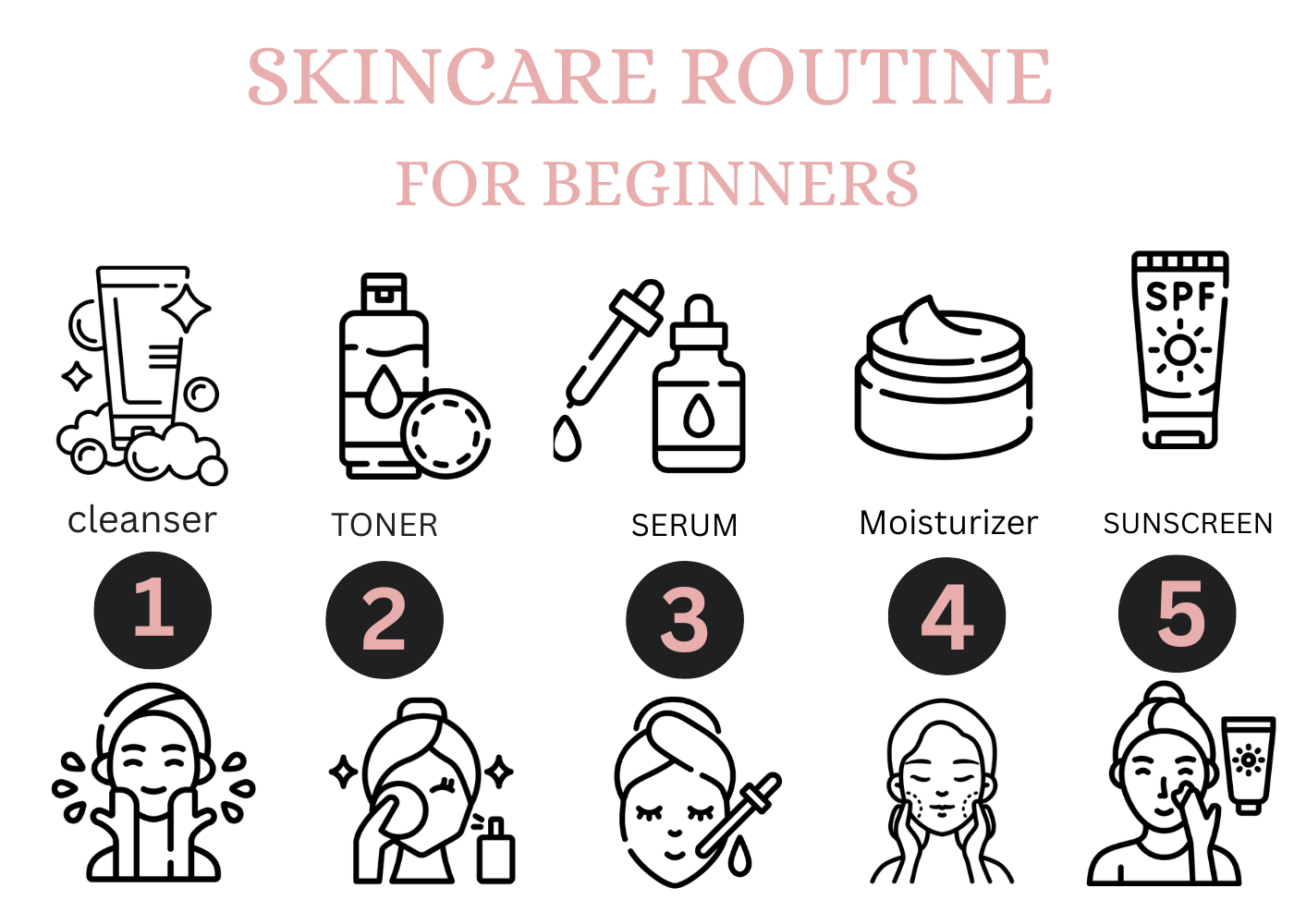
Who doesn’t dream of naturally glowing and healthy skin? But if you’re just starting out, skincare can feel overwhelming. With so many products, steps, and advice everywhere, most beginners ask the same question: “Where should I even begin?”
The truth is—you don’t need an expensive 10-step routine to achieve clear and radiant skin. A simple 5-step skincare routine is enough to keep your skin clean, hydrated, and protected. Once you get comfortable, you can slowly add serums, masks, or advanced treatments to upgrade your routine.
In this blog, we’ll walk through an easy and effective skincare routine that works for all skin types.
Step 1: Know Your Skin Type
Before you pick any product, you must understand your skin type. Using the wrong products can often make skin problems worse.
Oily Skin → Shiny appearance, acne-prone, enlarged pores.
Dry Skin → Feels tight, rough, and flaky.
Combination Skin → Oily T-zone (forehead, nose, chin) but dry cheeks.
Sensitive Skin → Reacts easily with redness, itching, or irritation.
Quick test: Wash your face with a gentle cleanser and wait for 1 hour (without applying anything). If your skin feels tight → dry. If it gets shiny → oily. If both → combination.
Step 2: Cleansing (Morning & Night)
Cleansing is the foundation of every skincare routine. It removes dirt, sweat, oil, and makeup so your pores stay clean and your skin can breathe.
Oily skin → Gel or foam cleansers that control excess oil.
Dry skin → Creamy or hydrating cleansers with glycerin or hyaluronic acid.
Sensitive skin → Mild, fragrance-free cleansers.
Pro Tip: Wash your face only twice a day (morning and night). Over-washing can strip away natural oils and cause irritation.
Step 2: Toning
Toner balances your skin’s pH and preps it for the next steps. It can also tighten pores and add hydration.
Oily/Acne-prone skin → Toners with salicylic acid or niacinamide.
Dry skin → Hydrating toners with rose water, aloe vera, or hyaluronic acid.
Sensitive skin → Alcohol-free and fragrance-free toners.
Step 3: Serum
A serum is a lightweight product packed with active ingredients that target specific skin concerns. This is where you can customize your routine according to your needs.
For Brightening & Glow → Vitamin C serum (best in the morning).
For Oil Control & Pores → Niacinamide serum.
For Hydration → Hyaluronic acid serum.
For Acne/Exfoliation → AHA/BHA serum (use only at night, not daily).
Pro Tip: Always apply serum after toner and before moisturizer. Start with 2–3 times a week, then increase usage once your skin adjusts.
No matter your skin type, moisturizer is a must. It locks in hydration and strengthens your skin barrier.
Step 4: Moisturizing
Oily skin → Lightweight, gel-based moisturizers.
Dry skin → Rich, cream-based moisturizers.
Combination skin → Use gel for the oily zone and cream for dry areas.
Sensitive skin → Fragrance-free and soothing formulas.
Pro Tip: Never skip moisturizer—even oily skin needs hydration!
Step 5: Sunscreen (Morning Only)
If there’s one product you should never skip, it’s sunscreen. UV rays damage skin, cause premature aging, dark spots, and tanning.
Choose SPF 30 or higher, broad-spectrum.
Oily skin → Gel-based or matte finish sunscreen.
Dry skin → Creamy or moisturizing sunscreen.
pro Tip: Reapply every 2–3 hours if you’re outdoors.
Night Routine Add-ons (Optional)
Once you’ve built the habit of a basic routine, you can slowly add extra products at night:
Serums:
Vitamin C → Brightens and fades spots.
Niacinamide → Controls oil and strengthens barrier.
Hyaluronic Acid → Deep hydration.
Weekly Care:
Gentle exfoliation (1–2 times a week).
Hydrating or clay masks depending on your skin type.
Common Mistakes Beginners Should Avoid
- Skipping sunscreen.
- Trying too many products at once.
- Expecting instant results (skincare needs consistency).
- Using harsh scrubs daily.
- Sleeping with makeup on.
Conclusion
Building a skincare routine doesn’t have to be complicated. Start with Cleanse → Tone → Moisturize → Sunscreen—this simple 4-step routine is all you need to achieve healthy, glowing skin. Once you’re consistent, you can explore serums, masks, and treatments to address specific concerns.
Remember, skincare is not about perfection—it’s about consistency and care.
FAQs
Q1. Do I really need a serum as a beginner?
Not necessarily. If you’re just starting, cleanser, moisturizer, and sunscreen are enough. But adding a serum helps target specific concerns like acne, dullness, or dryness, so it’s a great addition once you’re consistent.
Q2. Can I skip moisturizer if I have oily skin?
No. Even oily skin needs hydration. Skipping moisturizer can make your skin produce even more oil. Just choose a lightweight, gel-based formula.
Q3. Do I need sunscreen if I stay indoors?
Yes! UV rays can pass through windows and cause skin damage even inside your home. Always wear at least SPF 30.
Q4. Can I use Vitamin C and Niacinamide together?
Yes, they can be used together in a routine. But if you’re a beginner, start with one serum at a time to see how your skin reacts.
Q5. How long does it take to see results from a skincare routine?
Be patient—visible results usually take 4–6 weeks of consistent routine. Skincare is about long-term care, not overnight miracles.
Q6. How often should I exfoliate my skin?
1–2 times a week is enough. Over-exfoliation can damage your skin barrier and cause irritation.
Q7. What’s the most important step in skincare?
Sunscreen. It protects your skin from premature aging, tanning, and sun damage.
